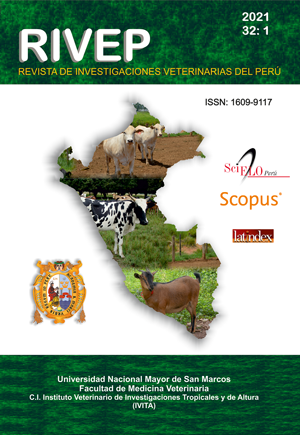Effect of dose of equine chorionic gonadotrophin (eCG) associated with short estrus synchronization protocols on reproductive performance of sheep hair
DOI:
https://doi.org/10.15381/rivep.v32i1.17775Keywords:
estrus, fertility, synchronization, tropics, eCG, hair sheepAbstract
The aim of the study was to compare three doses of eCG associated with a short heat synchronization protocol in hair sheep. A total of 48 ewes were oestrous synchronized with intravaginal sponges impregnated with medroxyprogesterone acetate inserted for a period of six days. Upon removal of the sponge, a prostaglandin F2α analogue was applied. The animals were randomly divided into four groups: Control (without eCG) and T1, T2 and T3 with the application of 100, 250 and 400 IU of eCG, respectively. Oestrous detection and mating were made with four males of recognized fertility. The pregnancy diagnosis was made on day 60 after mating by transrectal ultrasound. The interval to heat and the rates of presentation of oestrous, pregnancy and prolificacy were determined. The interval of the onset of oestrous was shorter in T3 (37.1 ± 12.0 h) compared to the other treatments (T2: 60.8 ± 25.0 h; T1: 52.01 ± 17.0 h and control: 58.3 ± 10.0 h) (p <0.05). The oestrous presentation and pregnancy rate were 100% in T3, being lower in the other groups (p<0.05). The prolificacy rate was significantly higher in T3 (2.3 lambs per female), compared to T2 (1.2), T1 (1.3) and control (1.25). It is concluded that the application of 400 IU of eCG in the short heat synchronization protocol improves the reproductive performance in hair sheep.
Downloads
Downloads
Published
Issue
Section
License
Copyright (c) 2021 J. López, D. Salinas, A. Baracaldo-Martínez, C. Gómez, D. Herrera Ibatá, J.E. Atuesta-Bustos

This work is licensed under a Creative Commons Attribution-NonCommercial-ShareAlike 4.0 International License.
AUTHORS RETAIN THEIR RIGHTS:
a. Authors retain their trade mark rights and patent, and also on any process or procedure described in the article.
b. Authors retain their right to share, copy, distribute, perform and publicly communicate their article (eg, to place their article in an institutional repository or publish it in a book), with an acknowledgment of its initial publication in the Revista de Investigaciones Veterinarias del Perú (RIVEP).
c. Authors retain theirs right to make a subsequent publication of their work, to use the article or any part thereof (eg a compilation of his papers, lecture notes, thesis, or a book), always indicating the source of publication (the originator of the work, journal, volume, number and date).










